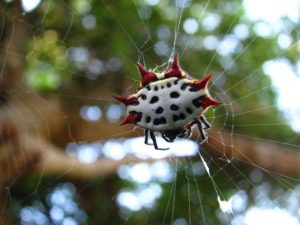During the first half of my observations I became interested specifically in the spiny orb- weaver spider. So, during the second half of my observations, I decided to focus on that specific species of spider. I didn’t notice many changes in the spiders. They stayed in the same kinds of locations: near shrubs. Areas with flowers tended to be more abundant in spiders. So instead of focusing on changes I decided to focus on two things: their color and their webs. Their webs were specifically really cool to me, because they do not look like typical spider webs. Their symmetry and silk tufts puts them apart from the other webs found in Blunn Creek. Additionally, their spider webs seem to be essential to their daily lives. I know that spider webs in general are a big part of spider’s lives, but every time I found a spiny orb weaver, it was on a web. Most of my observations were them just sitting in the center of the web (which makes me assume that I only saw female spiny orb weaver spiders and no males).
Since I was curious, i researched both the significance of their webs and colors. I learned that they are not very active spiders, and so they wait on their web for prey. Like Michael Price mentioned in his article, spiny orb weaver spiders have very bad eyesight. Therefore they don’t move much. Instead the spider sits and waits on the web. She depends on vibration from the web to know when a prey has landed and to find its location (Price). The webs location is usually in shrubs close to the ground in order to be in the pathway of small bugs and flies, instead of butterflies and bigger bugs. The silk tufts serve to warn bigger animals like birds to not fly through the web in order to save reconstruction time. These spiders are not very mobile, which explains why I only saw them sitting on their webs. Studies have shown that more prey are caught in their webs, when the spider is present than when the web is found empty.
I also read an article about the significance of the color of the spiders. Vanderhoff, Byers, and Hanna conducted research in which they found spiny orb weavers on their webs and split them into two groups. The first group was blackened with a sharpie, covering the spider’s color. The second spiders were left with their color. They believed that they would find that that the colors attracted prey because they resembled the same types of colors found on the flowers in the shrubs (Vanderhoff). However, the spiders who were blackened captured more prey. However, they found that their results were not significant. They would need a bigger sample size, and a way to find out if the smell of the sharpie had anything to do with it. Either way it was interesting to read this article. It shows that the spiny orb weaver’s behavior contradicts that of many other spiders, which is why I find them so interesting.
Overall, I enjoyed studying these spiders and feel like I learned a lot. I think it would be interesting to find out what they do during the winter when all of the flowers are gone.
Bibliography
Vanderhoff, E. N., Hanna, C.J. & Byers, S.j. (2008). Do the Color and Pattern of Micrathena
gracilis (Araneidae) Attract Prey? Examination of the Prey Attraction and Crypsis
[electronic resource]. Journal of Insect Behavior, 21 (6), 469-475
Price, Michael. Wild About Texas: Spiny Orb Weaver. 28 October, 2014.
http://www.myplainview.com/opinion/editorials/article/Wild-About-Texas-Spiny-backed-
rbweaver-8396946.php
